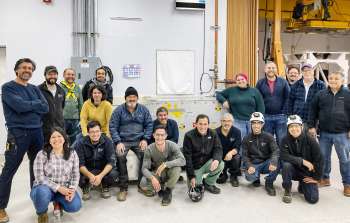sci24031 — Announcement
Farewell IGRINS, Hello IGRINS-2
May 9, 2024
On 22 April 2024, IGRINS (the Immersion GRating INfrared Spectrograph) came off the Gemini South telescope for the last time and was packed up to be shipped back to McDonald Observatory. It was built by KASI (the Korea Astronomy and Space Science Institute) and The University of Texas at Austin/McDonald Observatory. IGRINS offers high-resolution (R=45,000) near-infrared capabilities covering the wavelength range from 1.45 to 2.45 microns (the H and K bands). A silicon immersion grating and two additional cross-disperser gratings (VPH; volume phase holographic) allows it to be compact. Having no moving cryogenic parts makes IGRINS operations, maintenance, and data analysis simple.
This has made it useful in a wide range of conditions and, therefore, a popular instrument within the Gemini user community, seeing a consistent demand ranging between 15% and 25% of the total time requested at Gemini South. IGRINS science ranges from young stellar objects to exoplanets and beyond. There have been at least 32 scientific papers published by members of all Gemini partner countries in peer-reviewed journals and more are in preparation.
It was initially used on the Gemini South telescope for one semester in 2018A and returned in 2020A for an extended stay as a long-term visitor. The original agreement between Gemini and the IGRINS team, made in 2019, outlined a three-year visit spanning six semesters starting from 2020A. However, discussions in 2022 focused on the extension of its visit led both parties to identify 2024A as the final semester, given the increasing demand for a new facility instrument, GHOST, which may limit the availability of IGRINS at Gemini South. Furthermore, McDonald Observatory has expressed an interest in reclaiming IGRINS for their 2.7-meter telescope (the Harlan J. Smith Telescope) to improve their telescope demand. They would like to focus on the interstellar medium and other extended source sciences, for which IGRINS is better suited on a smaller telescope.
After the instrument was packed, Gemini staff and the IGRINS team were treated to a celebratory presentation by IGRINS instrument scientist Greg Mace, followed by cake and conversation. During this sad goodbye to IGRINS, the newly built IGRINS-2, which is an improved version of IGRINS, was undergoing commissioning at Gemini North. The KASI and Gemini IGRINS-2 team completed a seven-night observing run with software testing remaining from the last two telescope integration runs, Gemini engineering and science operations staff training, and verification of different science cases. Data from the Telescope Integration runs in last October and January, and the Commissioning run in April will be made available in early July.
About the Announcement
| Id: |
ID
sci24031
|
